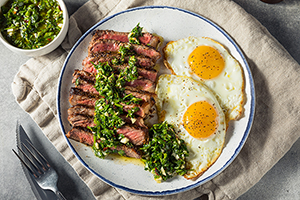



| By Dr. Ronald Hoffman
The Bible refers to the olive tree as the “tree of life.” Olives, the ripe fruit of the tree, yield healthy monounsaturated fats and phytochemicals that act as potent antioxidants. Research on the benefits of olive oil abounds in scientific literature. Yet, people are still not aware of the amazing healing powers of another component of the olive tree, the leaves.
 The olive tree, botanically designated as Olea europaea, brings to us a promising herbal product known as olive leaf extract. The ancient Egyptians regarded olive leaf as a symbol of heavenly power, and in keeping with that belief, they extracted its oil and used it to mummify their kings. The healing powers of olive leaf were realized as early as the 1880s when it was utilized to counteract malaria. According to the 1854 Pharmaceutical Journal of Provincial Transactions (pp. 363-354), Hanbury stated that a “decoction of the leaves” of the olive tree had been found to be extremely effective in reducing fevers due to a severe and otherwise often-fatal disease that swept the island of Mytilene in 1843. The olive leaf extract was reported subsequently to be more effective in its fever-lowering properties than quinine. Hanbury recalled that similar observations had been made in France and Spain between 1811 and 1828. It appears that in the early 19th century, Spanish physicians sometimes prescribed olive leaves as a “febrifuge,” and often used them to treat cases of intermittent fever (2). Hanbury concluded that the properties of the tree Olea europaea deserved more extensive investigation.
The olive tree, botanically designated as Olea europaea, brings to us a promising herbal product known as olive leaf extract. The ancient Egyptians regarded olive leaf as a symbol of heavenly power, and in keeping with that belief, they extracted its oil and used it to mummify their kings. The healing powers of olive leaf were realized as early as the 1880s when it was utilized to counteract malaria. According to the 1854 Pharmaceutical Journal of Provincial Transactions (pp. 363-354), Hanbury stated that a “decoction of the leaves” of the olive tree had been found to be extremely effective in reducing fevers due to a severe and otherwise often-fatal disease that swept the island of Mytilene in 1843. The olive leaf extract was reported subsequently to be more effective in its fever-lowering properties than quinine. Hanbury recalled that similar observations had been made in France and Spain between 1811 and 1828. It appears that in the early 19th century, Spanish physicians sometimes prescribed olive leaves as a “febrifuge,” and often used them to treat cases of intermittent fever (2). Hanbury concluded that the properties of the tree Olea europaea deserved more extensive investigation.
In the early1900s scientists isolated a bitter compound called oleuropein from olive leaf that was thought to give the olive tree its disease resistance. In 1962 an Italian researcher recorded that oleuropein had the ability to lower blood pressure in animals. Other European researchers validated that claim and also found it to increase blood flow in the coronary arteries, relieve arrhythmia and prevent intestinal muscle spasms. In the years to come, a Dutch researcher identified that a primary ingredient in oleuropein inhibited the growth of viruses, bacteria, fungi and parasites. This chemical was elenolic acid. Further European research determined this compound to have strong bactericidal, antiviral and antifungal capabilities. A safety study on calcium elenolate was tested with laboratory animals and published by the Upjohn pharmaceutical company in 1970. The study concluded that even in doses several hundred times higher than recommended, no toxic or other adverse side effects were discovered.
Health professionals first started using olive leaf extract in 1995 when it first became available. Although we do not have a long-term perspective as yet, initial results are very positive. We see a very promising and unique herb with multiple applications. It shows considerable therapeutic action against many common conditions. In short, it appears to be living up to its unique background and expectations.
From research and clinical experience to date, we can say that supplemental olive leaf may be beneficial in the treatment for conditions caused by, or associated with, a virus, retrovirus, bacterium or protozoan. Among those treatable conditions are: influenza, the common cold, candida infections, meningitis, Epstein-Barr virus (EBV), encephalitis, herpes I and II, human herpes virus 6 and 7, shingles (Herpes zoster), HIV/ARC/AIDS, chronic fatigue, hepatitis B, pneumonia, tuberculosis, gonorrhea, malaria, dengue, severe diarrhea, and dental, ear, urinary tract and surgical infections.
Many people who live stressful lives or who may be particularly susceptible to colds and viruses may benefit from long-term use of olive leaf as a preventive agent. Some patients have expressed other unexpected benefits of olive leaf including improved psoriasis, normalization of heart beat irregularities, diminished cravings, and less pain from hemorrhoids, toothaches and chronically achy joints.
Research suggests that olive leaf may be a true antiviral compound because it appears to selectively block an entire virus-specific system in the infected host. It then appears to offer healing effects not addressed by pharmaceutical antibiotics. Olive leaf’s broad killing power includes an ability to interfere with critical amino acid production for viruses; an ability to contain viral infection and/or spread by inactivating viruses by preventing virus shredding, budding or assembly at the cell membrane; and the ability to directly penetrate infected cells and stop viral replication.
After exhaustive research, Dr. Hoffman is proud to announce his version of olive leaf extract. What makes this product so unique is the fact that it is standardized to contain a minimum of 20 percent oleuropein per capsule. The actual content can be as high as 23 percent. Remember, oleuropein is the active antibacterial, antiviral, antifungal and antiparasitic component of olive leaf. Inferior products abound, partially due to confusion. For example, Dr. Hoffman’s own olive leaf extract contains 500 mg of olive leaf extract, standardized to 20 percent oleuropein per capsule and many people only focus on the 500 mg. Sure, I have found 500 mg capsules of olive leaf in health food stores, but the usual amount of oleuropein (the active component) is only 6 percent. The highest percent of oleuropein I have ever found in a bottle of olive leaf is 12 percent, and that costs $40 per bottle for 60 capsules. Additionally, many olive leaf extract supplements do not contain the listed amount of oleuropein. Dr. Hoffman specifically researched this fact and makes sure that his brand of olive leaf extract contains what is listed and functions exactly as he intends. Dr. Hoffman employs olive leaf extract for most bacterial, viral, parasitic and fungal conditions. There are many unique uses for this medicinal herb. The key to the benefits of olive leaf extract is to find a product that contains enough of the active constituent to achieve the desired outcome.
Dosage: for health maintenance take one or two 500 mg capsules (20 percent oleuropein), twice daily with meals. For the common cold take either two 500 mg capsules, 4 times per day with meals, or one capsule every hour while awake. For long standing infections or candida, take two capsules, three to four times per day, with meals.
References
Hanbury D. On the febrifuge properties of the olive (Olea europea, L.), Pharmaceutical Journal of Provincial Transactions, pp. 353-354, 1854.
Cruess WV, and Alsberg CL, The bitter glucoside of the olive. J Amer. Chem. Soc. 1934; 56:2115-7.
Veer WLC et al. A Compound isolated from Europea. Recueil,1957; 76:839-40.
Panizzi L et al. The constitution of oleuropein, a bitter glucoside of the olive with hypotensive action. Gazz. Chim. Ital; 1960; 90:1449-85.
Renis HE, In vitro antiviral activity of calcium elenolate, an antiviral agent. Antimicrob. AgentsChemother., 1970; 167-72.
Petkov V and Manolov P, Pharmacological analysis of the iridoid oleuopein. Drug Res., 1972; 22(9); 1476-86.
Zarzuelo A et al, Vasodilator effect of olive leaf, Planta Med., 1991; 57(5)417-9.
The evaluation of long-term effects of cinnamon bark and olive leaf on toxicity induced by streptozotocin administration to rats. J Pharm Pharmacol 1999 Nov;51(11):1305-12.
Though we think of declining estrogen as the hallmark of menopause, it's actually common for…

Up to 12 percent of Americans have ulcers at some point in life. Peptic ulcers…
Gallbladder disease is a modern illness. An estimated 20 million Americans have gallbladder disease. The…

We’re living longer, but cognitive decline threatens to rob us of quality of life in…

Dr. Antonio Bianco, recipient of the American Thyroid Association’s John B. Stanbury Thyroid Pathophysiology Medal,…

There’s a misconception among low-carb dieters. Many people believe a low-carb diet is much higher…

Leyla Weighs In: Eating for Energy and Emotional Well-Being

Our virtual voicemail is open 24/7, so there's no need to wait to submit your questions for Dr. Hoffman. Leave a message, and you may hear your question featured on the Intelligent Medicine radio program!